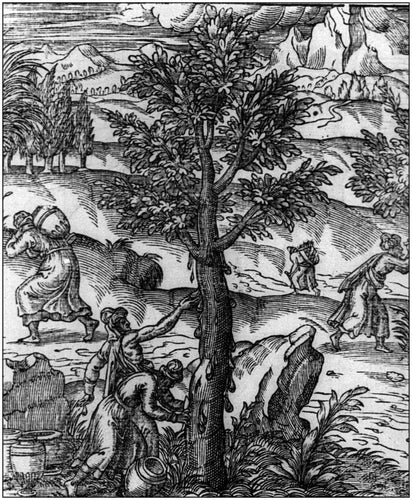
How Boswellia Sacra Is Harvested in Oman
Awaken To The OneShare
The Sacred Resin: How Boswellia Sacra Is Harvested in Oman
Frankincense has been revered for thousands of years for its captivating fragrance, spiritual significance, and medicinal properties. Among the various types of frankincense, Boswellia sacra stands out as one of the most prized and sought-after varieties. Sourced primarily from the arid landscapes of Oman, Boswellia sacra is not just a resin—it’s a sacred gift from nature. In this blog, we’ll explore the traditional and sustainable methods used to harvest Boswellia sacra in Oman, shedding light on the meticulous process that ensures the purity of this extraordinary resin.
The Mystical Tree Behind the Resin
Boswellia sacra, often referred to as the “sacred frankincense,” is native to the dry, rocky terrains of the Arabian Peninsula, particularly in Oman, Yemen, and parts of Somalia. The tree, which can grow up to 8 meters tall, has a unique ability to thrive in some of the harshest environments on Earth. Its gnarled branches and leaves may appear unremarkable at first, but it’s the resin that these trees produce that makes them so special.
When the tree is wounded, it secretes a milky, aromatic sap, which hardens into droplets known as frankincense. The resin is not only used for incense but is also prized for its therapeutic benefits in essential oils and skincare products.
Traditional Harvesting Methods
Harvesting Boswellia sacra is a delicate art, passed down through generations of Omani farmers and artisans. The process requires patience, skill, and a deep respect for the land and the tree itself. Here’s how the harvest typically unfolds:
1. Wounding the Tree
The first step in harvesting frankincense is creating small incisions or wounds on the tree's bark. This is usually done with a sharp, handmade knife or chisel. These cuts allow the resin to ooze out from the tree, a process that’s known as "tapping." Unlike modern methods of tapping other trees for their sap, the wounds on Boswellia sacra are shallow and precise, ensuring the tree isn’t harmed in the long term.
The incisions are made at the start of the cooler months, when the resin flow is most abundant. Typically, the tree is wounded several times over the course of a year, with each wound being refreshed every few weeks to allow the resin to flow continuously.
2. Collecting the Resin
Once the resin oozes out of the tree, it begins to harden into droplets within a day or two. These droplets are carefully scraped off the tree’s bark and gathered by hand. The process is time-consuming and requires a deep knowledge of the trees’ health and the resin’s quality. Farmers often use wooden tools to collect the hardened resin, ensuring that it’s preserved in its purest form.
Harvesting takes place during the dry season, when the sap has the right consistency and is easiest to collect. After each collection, the tree is allowed to heal before it is tapped again, ensuring that it remains healthy and can continue producing resin for years to come.
3. Sorting and Processing the Resin
Once the resin is collected, it is carefully sorted based on its quality and purity. The best quality frankincense, known as "Hojari," is clear, golden, and aromatic. Lower grades of resin may be cloudier and less fragrant. The highest quality frankincense is carefully preserved and sold for use in religious rituals, perfumery, and premium wellness products.
The resin is sometimes washed to remove impurities, but this process is done with care to maintain the integrity of the resin's natural fragrance and beneficial properties. It is then packaged and sent to markets across the world, where it’s transformed into incense sticks, essential oils, and skincare products.
Sustainability and Conservation
The harvesting of Boswellia sacra is an ancient practice, but in recent years, there has been growing concern about the sustainability of this valuable resource. Over-harvesting and environmental degradation pose threats to the survival of the Boswellia trees in the wild.
Fortunately, efforts are being made to ensure that frankincense harvesting in Oman is both sustainable and responsible. Many Omani farmers and harvesters now follow strict guidelines for tapping and managing the trees to prevent damage. They are encouraged to leave enough of the tree’s bark intact, allowing it to continue producing resin for future harvests. Additionally, some farmers have begun to cultivate Boswellia sacra trees in controlled environments, reducing the pressure on wild populations.
The Cultural and Spiritual Significance
For centuries, frankincense has been woven into the cultural and spiritual fabric of Oman and other parts of the Arabian Peninsula. It has been used in religious ceremonies, as offerings to deities, and as a means of purifying the air and mind. The scent of frankincense is thought to connect the physical and spiritual worlds, making it a staple in meditation, prayer, and rituals.
Harvesting Boswellia sacra is not just about collecting resin—it’s about honoring the sacred relationship between the land, the trees, and the people who depend on them. Each step in the process reflects a deep respect for the environment and the generations of knowledge passed down through the ages.
Conclusion
The harvest of Boswellia sacra frankincense is a testament to the skill, patience, and cultural heritage of the people of Oman. The traditional methods used to extract this sacred resin ensure that it remains pure, potent, and sustainable for generations to come. Whether used in spiritual practices, wellness routines, or as a luxury fragrance, Boswellia sacra continues to be a revered treasure of nature. By supporting sustainable harvesting practices, we can ensure that this aromatic resin remains a cherished gift for years to come.
